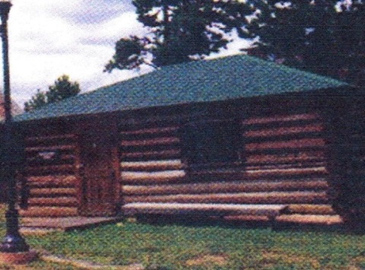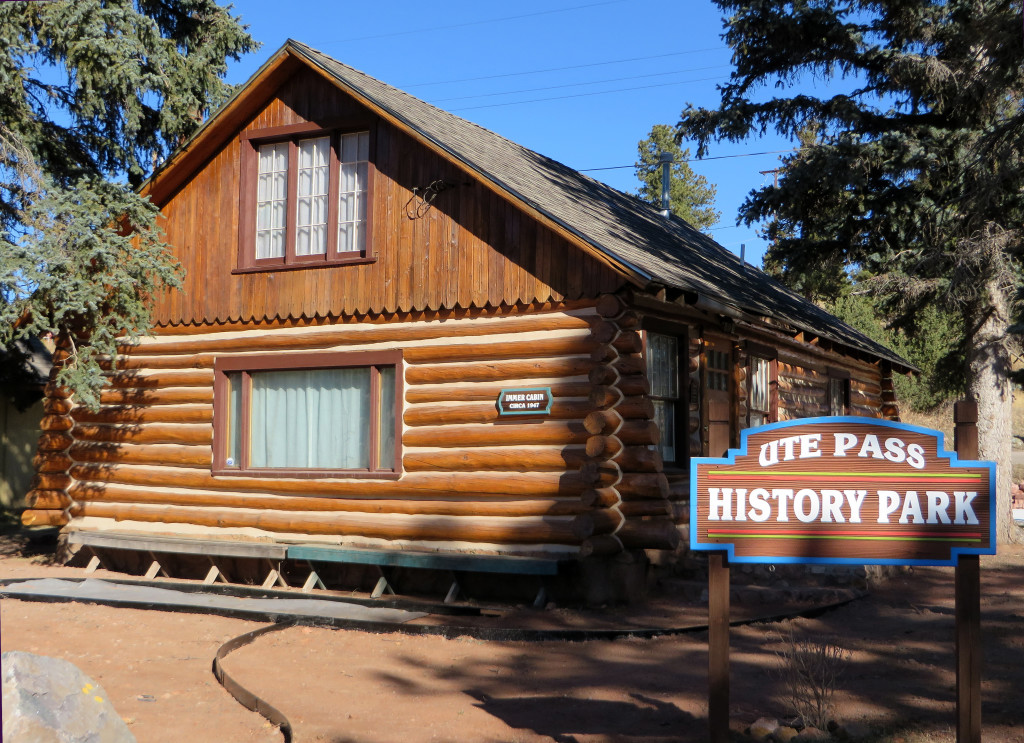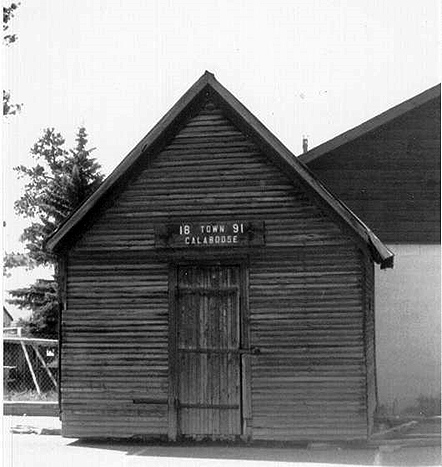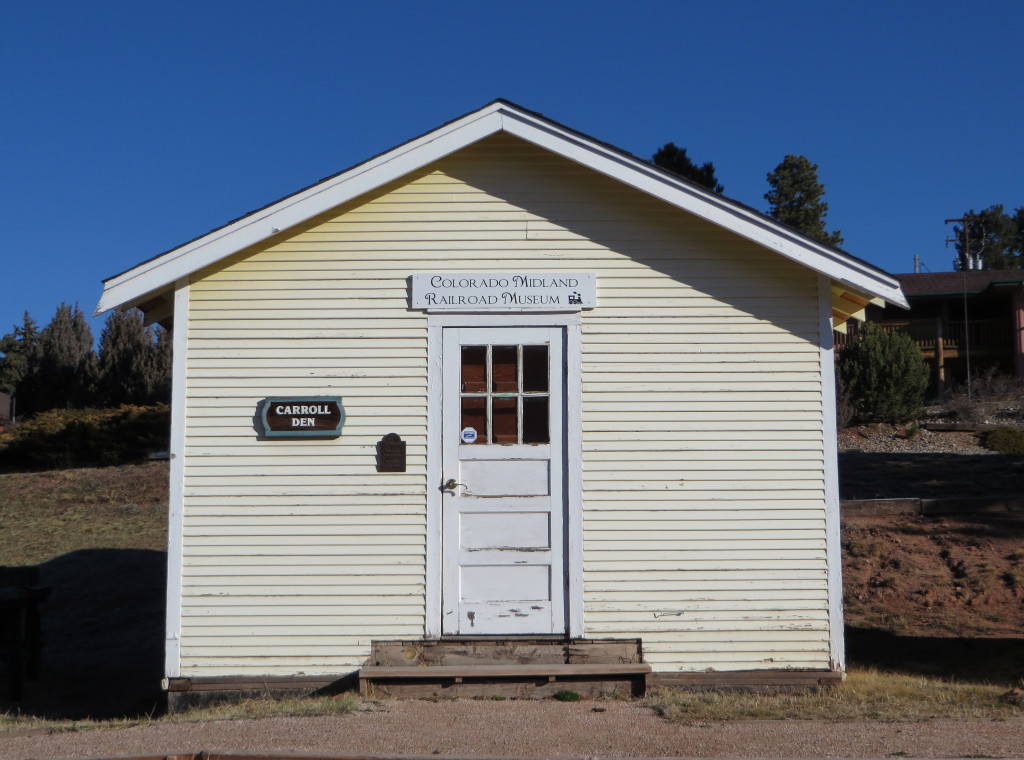The Carroll Den
The Carroll Den (also known as the railroad museum) was built by Woodland Park resident John Carroll in a style similar to the outbuildings used for storage by the Colorado Midland Railway.
The Colorado Midland Railway was a vital part of the lives of the Carroll family. John and Gertrude owned a store in Divide from 1890 to 1897, and John was a tie contractor for the Midland Railway in 1897. John later bought N.W. Terrill’s grocery store in Woodland Park, and Gertrude Carroll became the town’s first postmistress, operating the post office inside their store. The mail and much of their merchandise arrived on the rails.
The Carrolls’ son, Hunter, married a woman named Ruby O’Connor. They raised cattle in South Park, shipping their livestock on the Colorado Midland. In 1919, they returned to Woodland Park, and Hunter went into business at the store with his father. Ruby was a teacher and wrote articles for the local newspaper. She and Hunter had four children.
In a 1977 oral interview, Ruby recalled that her father-in-law constructed this building to use as a den and a place to store his mineral collection. Others have referred to it as “the old boars’ den” – a gathering place for men to relax and maybe play a card game or two.
Some years later, former Teller County commissioner Cal Elder took ownership of the den. He donated it to the Ute Pass Historical Society in 1984. The Carroll Den was used as a museum building at the former Brazenhead, a popular Woodland Park restaurant in the 1990s, until its move to its current site in History Park. The exhibits inside honor the heritage of the Colorado Midland Railway and its impact on the towns of Ute Pass.
The Brockhurst Cabin
The Brockhurst Cabin was used by the Brockhurst Riding Academy of Green Mountain Falls. Henry and Lulu Brockhurst operated a dude ranch from 1928 to 1962, with guest cabins, ranch lodge, and a dining hall.
“As romantic as yesterday, as near as tomorrow, as truly western as the historic Pikes Peak Region of Colorado in which it is located, the Brockhurst Dude Ranch offers visitors healthful, zestful, recreational opportunities for rest and vacations such as only the colorful mountain country affords.”
– Brockhurst Ranch brochure
The ranch served both adults and children. Henry and Lulu had excellent riding skills, and range riding was a favorite activity among the guests. The cabin was used to store riding tackle and other equipment.
Some years later, Mr. and Mrs. Kwapil of Grand Rapids, Michigan, bought the cabin. In 1978, they leased it to the recently formed Ute Pass Historical Society for $1. The following year, they donated the cabin to the society.
The cabin was moved to the new Pikes Peak museum site in Cascade in the summer of 1986. It was moved again when the museum opened at the Brazenhead restaurant building in Woodland Park in 1991.
The cabin was moved one last time in 2002, to its current History Park site. It now features historic exhibits that represent Ute Pass history.
The Immer Cabin
 The Immer Cabin was built by Emil Christian Immer and his wife, Ethel Cogswell Immer. The Immers lived in a house trailer on the property while the house was built. John Farber supervised its construction in 1947.
The Immer Cabin was built by Emil Christian Immer and his wife, Ethel Cogswell Immer. The Immers lived in a house trailer on the property while the house was built. John Farber supervised its construction in 1947.
The log house was a popular place, with many out-of-state family members as frequent visitors. Although small, the house was cozy and filled with many family mementos, including a child’s bed and Emil’s Spanish-American War chest full of service memorabilia. Two comfortable chairs sat on either side of the large living room picture window, where the Immers spent many happy hours enjoying the view of the changing seasons and Pikes Peak.
Ethel lived there until her death in 1961. Her remains are buried in Evergreen cemetery. Emil lived in the cabin until his health declined. The house was sold upon his death in 1964.
Some years later, the cabin was used by the Woodland Park School District as a maintenance shop. The building was traded to the City of Woodland Park when it acquired the old high school building (now the Ute Pass Cultural Center).
The Ute Pass Historical Society is fortunate to have use of this historic cabin. It contains exhibits relating to town life in early Ute Pass communities.
The Calaboose
 The Calaboose was also known as the Woodland Park Jail. Built in 1891, the jail was originally located on the alley near Center Street, half a block from Midland Avenue.
The Calaboose was also known as the Woodland Park Jail. Built in 1891, the jail was originally located on the alley near Center Street, half a block from Midland Avenue.
The town paid McCulkey, Bright and Bay $36.58 for materials and labor on July 25, 1891 for construction of the building. A person identified as M. Abbott was paid $30 for repairs on November 2, 1896.
H.D. Hackman sold the lot where the Calaboose was located to the city of Woodland Park for $50 on June 6, 1932.
The word calaboose is a corruption of the Spanish word calabozo, which means dungeon. A calabozo was typically a free-standing, one-room structure and was usually built next to the sheriff’s office.
The Calaboose was moved to its present location in History Park in 2009.

